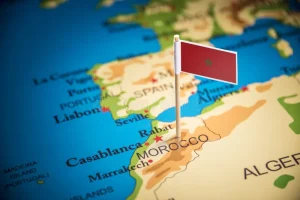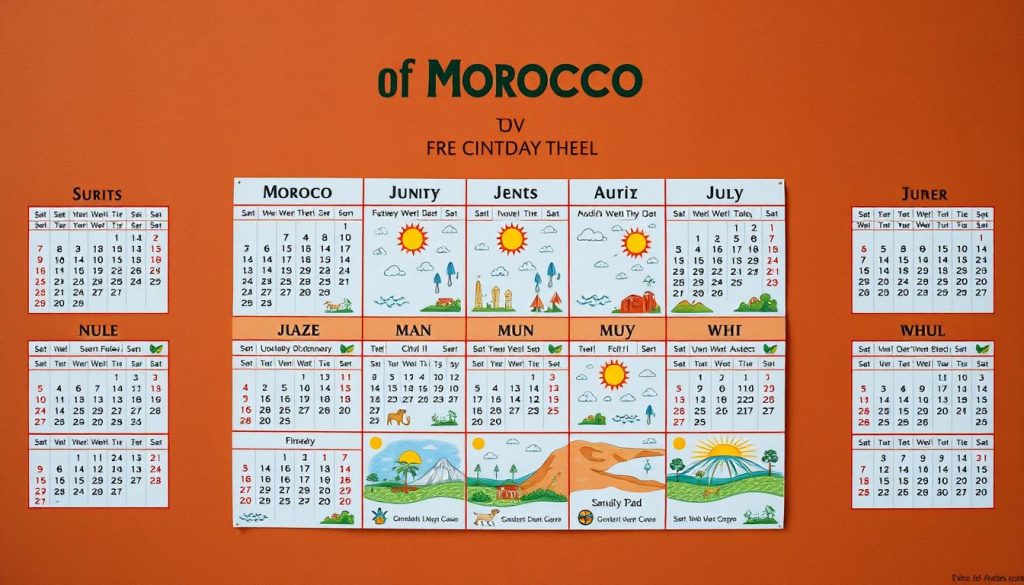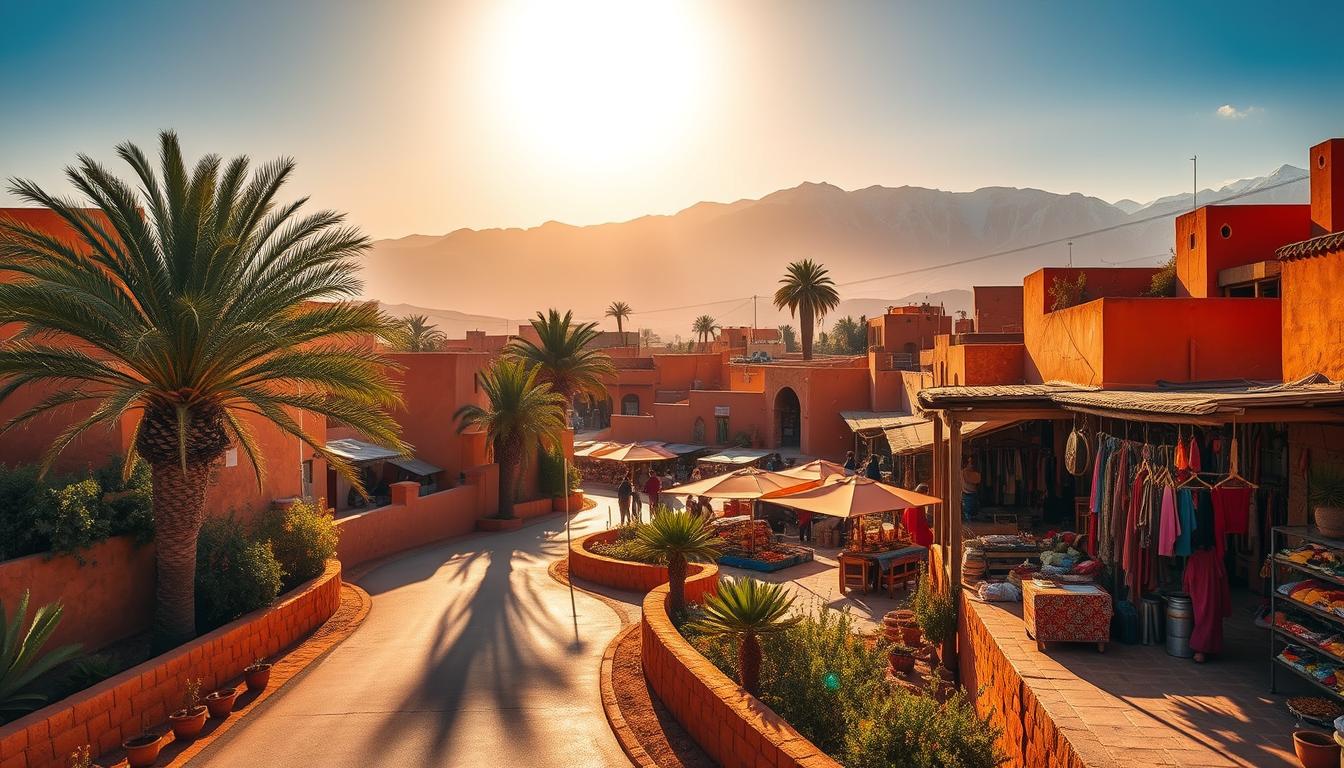Planning your dream trip to Morocco needs careful timing. Knowing the best time to visit can make your trip amazing. Your adventure in this vibrant North African place depends on picking the right travel seasons.
Morocco has different landscapes and experiences. You can find bustling cities, peaceful mountains, and vast deserts. Each area has its own weather and opportunities. Smart travelers know that timing is key in this culturally rich place.
Choosing the right travel dates is important. It’s about finding good weather, fewer tourists, and cultural events. Whether you want to save money or enjoy festivals, knowing Morocco’s travel seasons is crucial for a great trip.
Key Takeaways
- Understand regional climate variations across Morocco
- Avoid peak tourist seasons for better experiences
- Consider shoulder seasons for ideal travel conditions
- Research cultural events and festivals
- Plan activities based on specific regional weather patterns
Understanding Morocco’s Climate Zones and Seasonal Changes
Morocco has a wide range of landscapes, leading to different weather patterns in each area. From the coastal Mediterranean to the mountains and deserts, the country’s climate varies greatly. Knowing about these climate zones can help you plan your trip better.

The varied geography of Morocco leads to different seasons in each area. This affects how travelers experience the country. Planning your trip carefully is key to enjoying Morocco’s diverse climates.
Coastal Mediterranean Climate
The northern coast of Morocco has a Mediterranean climate. This means mild temperatures and moderate rain. Cities like Tangier and Tetouan have:
- Warm summers with temperatures around 75-85°F
- Mild winters averaging 50-60°F
- Significant coastal humidity
Atlas Mountains Weather Patterns
The Atlas Mountains have a big impact on the weather. The elevation changes cause big temperature differences:
| Elevation Range | Summer Temperatures | Winter Temperatures |
|---|---|---|
| Low Altitude | 70-85°F | 40-55°F |
| High Altitude | 50-65°F | 20-35°F |
Sahara Desert Conditions
The Sahara Desert is Morocco’s most extreme climate zone. The temperatures can change a lot between day and night:
- Summer daytime temperatures: 100-120°F
- Winter daytime temperatures: 65-75°F
- Nighttime temperatures can drop below freezing
When traveling through Morocco’s different climate zones, it’s important to prepare. Each area has its own needs for packing and planning.
Best Time To Go To Morocco: Month-by-Month Analysis
Planning your trip to Morocco means looking at the country’s different climates. Knowing the weather each month helps pick the best time to visit. This way, you can make the most of your trip.

- January-February: Cold in the mountains, mild by the coast
- March-April: Spring is in bloom, with nice temperatures
- May-June: These months are perfect for traveling, with warm days
- July-August: It’s very hot, and there are lots of tourists
- September-October: A great time to visit, with comfortable weather
- November-December: It’s cooler, and there are fewer people around
Every month has its own charm. Winter brings snow to the Atlas Mountains. Summer is great for desert adventures. Spring and fall are the best times to see Morocco’s beauty because the weather is just right.
What’s your favorite thing to do? If you love hiking, May or September are good. Beach fans should go in June or September for the best weather.
Here are some top times to visit:
- March-May for nice weather
- September-November for a comfortable climate
- December for winter fun and culture
Think about what you want to do, your comfort with heat or cold, and your travel plans. Morocco has something for everyone all year round.
Peak Tourist Seasons and Why They Matter
Planning your trip to Morocco needs careful thought. Knowing when the peak season is can make your trip better. It helps you avoid places that are too crowded.
Morocco’s tourism has its ups and downs. There are key times that really affect your trip. Knowing these can save you time, money, and stress.
Summer Tourism Rush
The summer, especially July and August, is the busiest time. Places like Marrakech, Casablanca, Fez, and the coast get packed.
- Marrakech
- Casablanca
- Fez
- Coastal regions
It’s very hot, over 100°F. Hotels cost more, and places to see are full.
Winter Holiday Crowds
Winter, especially around Christmas and New Year’s, is also busy. People from Europe and North America come for the warmer weather.
| Season | Crowd Level | Price Range |
|---|---|---|
| Summer Peak | Very High | Expensive |
| Winter Holidays | High | Premium |
Religious Festival Periods
Events like Ramadan and Eid change things a lot. These times can be hard to avoid crowds. Business hours are shorter, and travel might be harder.
For a real Moroccan experience, try the shoulder seasons. They have nice weather and fewer people. Planning well can make your trip unforgettable.
Shoulder Season Benefits: Spring and Fall Travel
Exploring Morocco in the shoulder seasons can change your travel game. Spring and fall are the best times to see Morocco with fewer people around. You get to see the real Morocco without the heat or crowds.
Traveling during the shoulder season has many perks:
- Mild temperatures perfect for outdoor adventures
- Significantly reduced travel costs
- More intimate cultural interactions
- Easier access to popular attractions
Spring (March to May) is a time of beauty with wildflowers everywhere. The weather is just right for Marrakech and the Atlas Mountains. Fall (September to November) has similar weather and harvest festivals.
| Season | Temperature Range | Travel Benefits |
|---|---|---|
| Spring | 60-75°F | Wildflower blooms, mild weather |
| Fall | 65-80°F | Harvest festivals, fewer tourists |
Plan your Morocco trip with flexibility and a sense of adventure. Bring layers, check local events, and dive into Morocco’s culture without the crowds.
Planning Your Visit Around Cultural Festivals and Events
Exploring Morocco’s vibrant culture means planning your trip for its best festivals. The country is full of cultural events that give travelers a peek into local traditions and modern life.
Morocco’s festivals are more than just events. They are a way to see the heart of this amazing country. Visiting during these times can make your trip unforgettable.
Traditional Moroccan Festivals
Traditional festivals highlight Morocco’s rich cultural heritage. Some top events to see include:
- Tafraoute Almond Blossom Festival in February
- Rose Festival in El Kelaa M’Gouna in May
- Imilchil Marriage Festival in September
Religious Celebrations
Religious events are a big part of Moroccan culture. Key celebrations include:
| Festival | Time of Year | Significance |
|---|---|---|
| Eid al-Fitr | End of Ramadan | Major Muslim holiday with family gatherings |
| Eid al-Adha | Summer/Fall | Commemorates Abraham’s willingness to sacrifice his son |
Modern Cultural Events
For modern experiences, Morocco has top-notch events:
- Fes Festival of World Sacred Music – A global music celebration in June
- Marrakech International Film Festival – Showcasing international cinema in November/December
- Essaouira Gnaoua World Music Festival – A unique musical experience in June
Visiting during these events makes your trip to Morocco unforgettable. It lets you dive into the country’s rich and diverse culture.
Budget-Friendly Travel Periods in Morocco
Traveling to Morocco doesn’t have to be expensive. Smart travelers can find the cheapest times to visit by knowing the budget travel seasons. It’s all about finding when prices are low and there are fewer tourists.
Morocco has affordable trips during certain times that offer unique experiences. The best times to visit on a budget are during the shoulder months. These months have nice weather and lower prices.
- Low Season (Mid-January to March): Lowest prices for accommodations
- Shoulder Seasons (April-May and September-November): Balanced prices and mild temperatures
- Avoid Peak Season (June-August): Highest prices and extreme heat
Planning ahead makes affordable Morocco trips easier. Here are some budget-friendly places to visit:
| Region | Budget Accommodation Cost | Best Cheap Months |
|---|---|---|
| Marrakech | $15-$30 per night | February, March |
| Fez | $20-$35 per night | November, December |
| Chefchaouen | $25-$40 per night | April, May |
Pro tip: Book your stay and flights during the week for more savings. Flexibility is your greatest asset when looking for budget-friendly Moroccan adventures.
Regional Travel Tips: Coast, Mountains, and Desert
Morocco is a country with different landscapes. Each area has its own charm. Knowing when to visit is key for a great trip.
Traveling in Morocco means understanding the seasons. Each area has its own challenges and joys for travelers.
Coastal Cities Timing
Spring and fall are the best times to see the Moroccan coast. Places like Essaouira and Casablanca are less crowded then. Enjoy the coast from April to May and September to October.
- Ideal coastal months: April, May, September, October
- Average temperatures: 68-75°F (20-24°C)
- Lowest tourist density
Mountain Excursions
Summer is the best time for mountain trips in Morocco. The Atlas Mountains are perfect for hiking. Go from June to September for the best trails.
| Mountain Region | Best Travel Months | Temperature Range |
|---|---|---|
| High Atlas | June-September | 55-75°F (13-24°C) |
| Middle Atlas | July-August | 60-80°F (15-27°C) |
Desert Adventure Planning
Planning a Sahara Desert trip needs careful thought. Winter is the best time, with cooler days and nights. Summer is too hot, with temperatures over 120°F.
- Recommended desert travel: November-February
- Daytime temperatures: 70-80°F (21-27°C)
- Nighttime temperatures: 40-50°F (4-10°C)
Traveling in Morocco requires flexibility and planning. Each area has its own best time to visit.
Weather Considerations for Popular Activities
Planning your Morocco outdoor activities needs careful thought about the weather. Different parts of Morocco offer special experiences that change with the seasons.
Exploring Morocco’s adventure sports seasons shows a wide range of activities. Each one is best at certain times of the year. The best times vary across the country’s different landscapes.
- Hiking in Atlas Mountains: Best from April to May and September to November
- Mild temperatures
- Clear mountain views
- Comfortable walking conditions
- Desert Activities: Ideal during spring and autumn months
- Moderate daytime temperatures
- Cooler nights for camping
- Reduced risk of extreme heat
For the best weather for Morocco sightseeing, consider these regional recommendations:
- Coastal regions: May to September for beach activities
- Marrakech: March to May for comfortable city exploration
- Sahara Desert: October to April for comfortable temperatures
Each region needs its own preparation. Coastal areas are great for surfing and water sports in summer. Mountain regions offer excellent trekking in shoulder seasons. The desert needs careful timing to avoid extreme temperatures.
Conclusion
Planning a trip to Morocco needs careful thought. The right time to visit can make your trip unforgettable. Weather, cultural events, and what you like are key to a great trip.
Spring and fall are the best times to visit Morocco. These seasons have nice weather and fewer people. The desert is cooler in these months, and coastal areas are mild.
Think about what you want to do. Morocco has mountains, cities, and festivals for everyone. Some like the light for photos, while others enjoy cultural events.
Traveling to Morocco can be rewarding if you plan well. Going off the beaten path can save money and lead to amazing experiences. Be open to new things and let Morocco surprise you.

